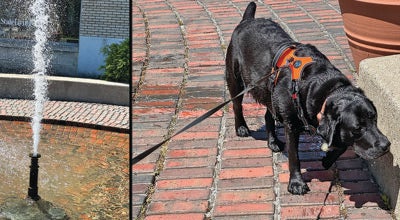Can officials force cleanup of rundown property?
Published 11:14 pm Saturday, May 30, 2009
It sounds like a simple proposition. See a mess. Clean it up. That is the typical mindset in turning an upside down situation right.
But nothing is simple when it involves the government. Or, more precisely, when it is the government versus the homeowner whose house is falling in; or the homeowner with weeds in the yard that need a quick trim with a machete; or the homeowner who thinks a rusting Ford Granada makes a great bird bath.
Just like neighbors, a city or village wanting to clean up its eyesores can use the tactic of shame as the first line of offense.
That has worked with success for the Village of Proctorville’s Mayor Charles Stapleton who came into office January of 2008 with cleanup guns blazing.
One of his first acts was to send letters to negligent property owners with a succinct message.
“If you don’t cut your yard, I will cut it for you and put it on your tax,” Stapleton said. “I cracked down on all. I got some of them. You just try to enforce the ordinance and they will fall in line.”
The ones who didn’t Stapleton filed through the auditor’s office to put the costs to clean up the yards on the homeowners’ tax bills. That was last summer and so far, he has yet to collect.
“Last year there was a mess up over the paperwork,” he said. “I’m supposed to be getting it in September. I stay right on them.”
Joining the crackdown recently was the Union Township Trustees who have adopted a program to clean up the eyesores in the county. Much of the teeth of their efforts comes from House Bill 50, sponsored by State Rep. Clyde Evans and signed by the governor in December 2007.
That allows townships to remove junk motor vehicles from public and private property and to borrow money to pay for removal of those vehicles and other debris from private property.
In March the Union Trustees held a public meeting concerning the project explaining its parameters.
“We will be allowed to serve people a notice to give them a chance to remove (the junked vehicles) or get them out of sight,” Trustee Rick Gue said at the time. “We will have someone actually do the towing, being under contract with the township.”
The trustees intend to assess the expense of towing to the car owner. The same is expected to be done for property that is overgrown with weeds or covered with debris.
The homeowner will be notified and given a time period to clean up the situation. If the homeowner ignores the notice, the township will go to court to get the area cleaned up.
But when the eyesore is not just as big as a house, it actually is the house, then can sending a forceful letter be that effective?
In 2006 Milton R. Dohoney Jr. became Cincinnati’s city manager. A year later he began the Neighborhood Enhancement Program where the community and city agencies attack the issue of blight. Cincinnati housing officials have discovered it’s an issue that is borne not only out of laziness and deliberate neglect but equally from poor financial judgment and the distressed economic condition facing this country.
At the top of that list are the massive number of foreclosures facing homeowners. Those properties are ripe to become neighborhood eyesores, according to Ed Cunningham, division manager with Cincinnati’s department of community development.
“When a foreclosure is filed, the first thing is the family will leave,” Cunningham said.
That happens either because the homeowners realize they will lose their house or they are forced out by the lenders. That means a vacant house issuing a siren call to intruders.
“When you have vacant house and people know it is a foreclosure, that sends a message to vandals. They will steal all the copper plumbing, strip it out and scrap it,” he said. “The destruction is amazing. I went to one yesterday and they took the copper wiring out. They took architectural features, anything decorated, even ripped the walls open to get the copper.”
Then that remnant of a home may next attract the ugly — and illegal — side of humanity from drug dealers to prostitutes.
“These vacant houses are magnets of crime,” Cunningham said.
What can happen next is after a foreclosure is filed, the bank puts it up for sale. However, oftentimes the property isn’t moving.
“It could sit there for months, six months or a year before the bank may or may not take it back,” he said.
If not, then the situation gets tossed into the laps of the city.
“The bank has the mortgage, they walk away. Who do you think will have to foot the bill to tear it down? The taxpayers of Cincinnati,” Cunningham said. “We tear one of these down and try to collect from the owners.”
However, tearing down the eyesore may leave an empty lot that looks prettier than before but is worth much less than the demolition costs. On average to tear down a structure, fill in the basement, clear up the lot and reseed can run on average $14,000, Cunningham said.
Now what is left is a vacant parcel worth only $2 or $3,000, but with a tax bill that is six times or more than the value of the parcel assessed to that property.
“It is not a winning situation when you have to tear one down,” he said. “Distressed properties in any area, a lot of it has to do with the housing market. Quite often the challenges are chasing the owners. They tend to buy and see these distressed properties. Some of them buy with the idea of flipping them.”
On the surface, that might sound like a way out, but that depends on the business acumen of the potential savior.
“A $5,000 to $7,000 would-be investor doesn’t have any idea of how to rehabilitate,” he said. “They have stayed up too late watching get-rich quick by buying real estate.”
Besides basic neglect, these properties often are filled with lead paint, asbestos, and other antiquated building products now deemed health hazards. Cunningham says the properties can need so much work that he calls them functionally obsolete.
If an eyesore is mortgage-free, Cunningham sees another option that can improve the landscape and keep a city from exercising the ultimate alternative.
In Cincinnati it’s partnering with nonprofit agencies to do home repairs for those homeowners who can’t afford to do them. The goal of the city is to try to keep homeowners in a home that is kept up.
If a lot is cleared, the city will often ask a neighboring land owner if he would like to buy the parcel.
“We can go to the tax bill and sue them, but the tax bill is the last resort,” Cunningham said. “All it does is tie up the lot.”




